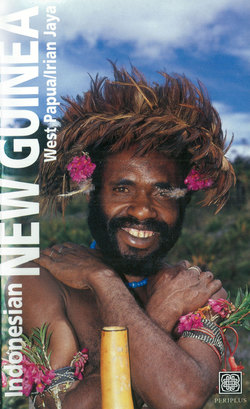Читать книгу Indonesian New Guinea Adventure Guide - David Pickell - Страница 21
ОглавлениеBIAK
Strategic
Island to West
Papua's North
When Biak served as a major air stopover on Garuda Airlines' flight to and from the United States, most passengers didn't even bother to disembark. This is a shame, because although Biak is not really developed for tourism, the island is rich in history and natural beauty.
Biak islanders are Melanesians, ethnically and culturally distinct from the majority of "mainland" West Papuans. Unlike other parts of West Papua, like the Baliem Valley, the traditional culture here has for the most part been wiped out by missionaries, and today everyone routinely dresses in western clothes.
But elements of the old lifestyle remain. Traditional drumming and dances, and fire-walking displays, still take place—although today these activities are not common, and must be arranged specially for visitors.
The bride price, still widely used on Biak, consists of antique porcelain plates, silver bracelets made from old Dutch or American coins, and cash money. The average value is currently $350. The wedding feasts, where this exchange is made, are often lavish affairs. Other rites of passage—such as a child's first haircut—are also honored. Magic still plays a role in Biak, particularly in attracting abundant catches of fish.
During World War II, in fact, tiny Biak loomed large on the world map. After the war, the Dutch took over the American airfields and docks and, during the 1960s, the Indonesian government followed suit. Today Biak is the hub of development with Hotel Biak Beach.
Geography and economy
Boot-shaped Biak Island, covering 1,834 square kilometers, extends 50 kilometers northwest to southeast, and averages 18 kilometers wide. The northernmost shore reaches within 60 kilometers of the equator, and the middle of the island lies at 1° south. The weather on Biak Island is hot and humid, sometimes uncomfortably so.
Supiori Island, northwest of Biak, is very nearly attached to Biak. It is split only by a tiny saltwater creek—Sorendidori—extending from Sorendidori Bay in the south to Sorendiweri Bay in the north. Just 100 kilometers west of Supiori is small Numfor Island.
Geologically, all these islands consist of uplifted coral limestone, with coastlines often ending in impressive cliffs as much as 60 meters from the waves below. The heavy rainfall has eroded the soft limestone into caves, which on Biak Island in particular played a historic role in World War II as a hideout for Japanese soldiers. Inland, the terrain is generally flat, with occasional low hills, except in the northern part of Biak and in Supiori. Bonsupiori, the highest hill in the district, reaches 1,034 meters in southern Supiori.
Biak, Supiori, Numfor, and the Padaido islands form one of nine administrative districts in West Papua. (Yapen is part of the Yapen-Waropen area, which includes Yapen and the coastal Waropen area on West Papua proper.)
The total population of the Biak area is a bit over 102,000, with about half of these living in Biak town and the surrounding area. Recent transmigrants, mostly Muslims from Java or Sulawesi and Christians from Ambon and Manado, have swelled the population of Biak town to an estimated 55,000. The island of Biak has 85,000 inhabitants; Supiori has 10,000 and Numfor 7,500. Eighty-five percent are Protestant Christians. The area's Catholics (2,000) and Muslims (10,700) live chiefly in Biak town.
Biak's economy looks to both the land and the sea. Taro is the staple crop, and manioc, sweet potatoes, soybeans and green vegetables are also grown. Copra, dried coconut meat, has long been the principal cash crop. Cacao, cloves and coffee are being developed.
Most gardens and plantations are located inland, behind the narrow coastal range. Chickens, and a few head of cattle and goats have been recently introduced to supplement the native pigs. Despite this diversity of livestock, most Biak islanders still get their protein from the seas.
During the past few years, Biak's economy has boomed thanks to timber and tuna fishing. A large sawmill, supplied with lumber from the north coast of West Papua, churns out plywood. Large-scale cutting operations are also proceeding on Biak itself. Commercial tuna fishing, started by the French and now run by Americans, is carried out by the Indonesian Van Camp Seafood Company. This operation produces up to 50,000 tons of locally canned tuna for export, along with frozen fish. Two other fleets of trawlers bring back to Biak chilled, sashimi-grade tuna.
Other sea products exported from Biak include trepang (dried sea cucumber) and sharks' fins, which end up in the Hong Kong and Taiwan markets.
The recent introduction of seaweed cultivation has given the economy of several coastal villages a welcome boost, and is also beginning to displace fish bombing and other damaging ways of exploiting the island's coastal waters. The seaweed (Eucheuma spp.) is grown on rafts criss-crossed with ropes in the quiet, sunlit shallows. After being harvested and dried, the seaweed is shipped off to Java and then Holland where it is processed into carrageenan. This valuable material is used in a variety of products such as cosmetics, toothpaste, pie-filling, ice cream and cheese. Depending on quality, the raw seaweed can fetch $500 a ton in Surabaya.
The power of the ancestors
Biak islanders are a seafaring people, and even a few decades ago the men's houses in Biak were topped by boat-shaped roofs, and the bones of the dead were stored in boat-shaped coffins. Languages related to that spoken here are found as far away as Halmahera.
[Note: The name "Irian" is itself a Biak word, coined by Biak islander Frans Kaisiepo, a representative at the Malino conference in 1946. "Irian" originally referred not to all of western New Guinea, but only the part nearest Biak, now the Waropen area. The rough sense of the word was "hot climate."]
